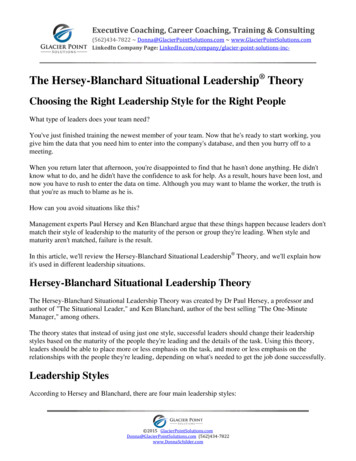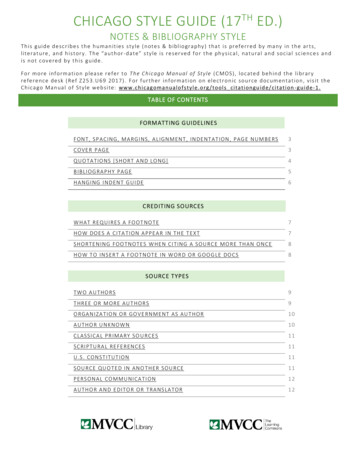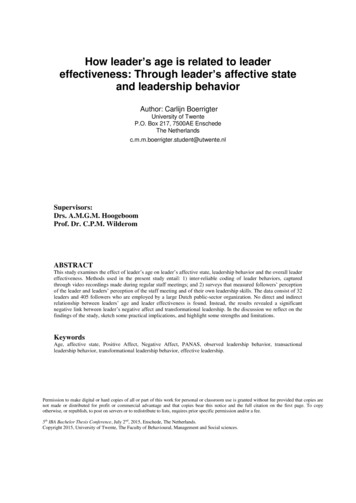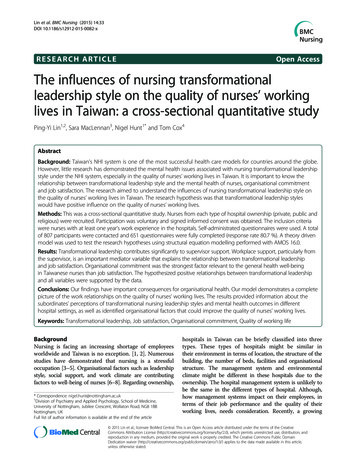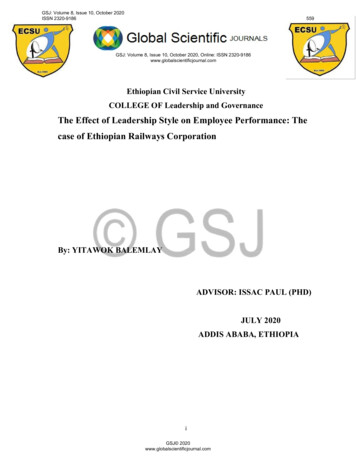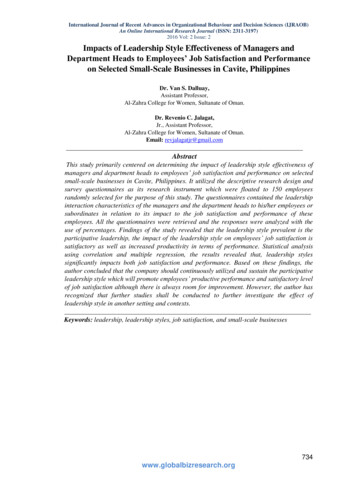
Transcription
International Journal of Recent Advances in Organizational Behaviour and Decision Sciences (IJRAOB)An Online International Research Journal (ISSN: 2311-3197)2016 Vol: 2 Issue: 2Impacts of Leadership Style Effectiveness of Managers andDepartment Heads to Employees’ Job Satisfaction and Performanceon Selected Small-Scale Businesses in Cavite, PhilippinesDr. Van S. Dalluay,Assistant Professor,Al-Zahra College for Women, Sultanate of Oman.Dr. Revenio C. Jalagat,Jr., Assistant Professor,Al-Zahra College for Women, Sultanate of Oman.Email: revjalagatjr@gmail.comAbstractThis study primarily centered on determining the impact of leadership style effectiveness ofmanagers and department heads to employees’ job satisfaction and performance on selectedsmall-scale businesses in Cavite, Philippines. It utilized the descriptive research design andsurvey questionnaires as its research instrument which were floated to 150 employeesrandomly selected for the purpose of this study. The questionnaires contained the leadershipinteraction characteristics of the managers and the department heads to his/her employees orsubordinates in relation to its impact to the job satisfaction and performance of theseemployees. All the questionnaires were retrieved and the responses were analyzed with theuse of percentages. Findings of the study revealed that the leadership style prevalent is theparticipative leadership, the impact of the leadership style on employees’ job satisfaction issatisfactory as well as increased productivity in terms of performance. Statistical analysisusing correlation and multiple regression, the results revealed that, leadership stylessignificantly impacts both job satisfaction and performance. Based on these findings, theauthor concluded that the company should continuously utilized and sustain the participativeleadership style which will promote employees’ productive performance and satisfactory levelof job satisfaction although there is always room for improvement. However, the author hasrecognized that further studies shall be conducted to further investigate the effect ofleadership style in another setting and contexts.Keywords: leadership, leadership styles, job satisfaction, and small-scale businesses734www.globalbizresearch.org
International Journal of Recent Advances in Organizational Behaviour and Decision Sciences (IJRAOB)An Online International Research Journal (ISSN: 2311-3197)2016 Vol: 2 Issue: 21. IntroductionIt is largely viewed that leadership is part and parcel of organization’s existenceregardless of the type of business organization. Whether the business structure is soleproprietorship, partnership, corporation and other types, leadership plays an important role inmanaging and leading the human resources, facilities, budgets and other resources in anefficient and effective manner. More so, for employees who are considered the organization’sbest assets and talents, effective leadership enable them to become highly productive andmore satisfied with their jobs. According to Mosadeghrad (2003), there are different styles ofleadership and it depends on the situations and circumstances of the organization and whattype it sees fit. It consists of autocratic, laissez-faire, and transformational leadership.Moreover, in small businesses these leadership styles are often considered and are mainlycontingent with the organization’s climate and culture of the people within the company.Furthermore, consensus from several studies and researches suggest the common leadershipstyles that are currently practiced by most organizations include but not limited to thefollowing: : (1) autocratic, (2) bureaucratic, (3) laissez faire, (4) charismatic, (5) democratic,participative, (6) situational, (7) transactional, and (8) transformational (Goleman, 1998;Yukl, 2002; Smith, 2006); and, Rothschild, 2008). However, Rad and Yarmohammadian(2006) maintains that, the use of leadership style is relative to the situations and conditions ofthe company or organization. In relation to this study, it sought to determine the type ofleadership style/s best suited to the organization in selected small-scale businesses in Cavite,Philippines being considered as a fast growing and relatively stable business destinationoutside of Manila. The main objective of the study is to measure how effective is theleadership style of the managers and department heads as perceived by the employees andstaffs of these businesses.According to Omolayo (2007), managing small-scale businesses are very challengingconsidering the lack of standard procedures and the increasing cases of employee turnovers.For this reason, it would be a challenging tasks for these small businesses most especially thatmany of the experienced and highly skilled employees leave the organization without clearreasons of leaving. Hence, the leadership style of the managers and heads creates impact onthe employees’ productivity and job satisfaction that will be extensively examined in thesucceeding sections (Al-Ahmadi, 2009).In view of the problem often encountered in small-scale businesses about leadership, theaim of this study is to determine the relationship and impact between leadership style toemployees’ job satisfaction and performance. It will also investigate what leadership style isevident and commonly used by the managers and heads of the selected cooperatives. Basedon this concept, the null hypotheses can be drawn:735www.globalbizresearch.org
International Journal of Recent Advances in Organizational Behaviour and Decision Sciences (IJRAOB)An Online International Research Journal (ISSN: 2311-3197)2016 Vol: 2 Issue: 2Hₒ1: There is no significant impact between leadership styles (Autocratic,Participative/Democratic, Laissez-Faire) to employee job satisfaction and performance.Hₒ2: There is no significant relationship between leadership style and employee jobperformance.2. Literature ReviewBorkowski, et. al. (2011) posits that, effective leadership defines the success of anyorganization. Accordingly, the view of Gary K. Hines posits that “It is through dynamism andeffective leadership that plays a vital role in the success of company’s management (Gadot,2007; Hugnes, R. L., Gonnett, R. C., & Curphy, G. J., 2006; Northouse, 2009; Cohen &Golan, 2007). However, leadership and management although often intertwined is a differentconcept. Leadership refers to people who have the visionary mindset and can be able to leadand influence others to become leaders in attaining the goals and objectives of the business.The supervisor’s position with the firm is to impose their authority which is driven by respectand trust from their followers. This in turn aids the leader to achieve the goals, plans andpurpose of the entire organization with joint efforts between the supervisor and thesubordinates.Management on the other hand is focused on the functions of running the business andtakes into major considerations such as authority, control and instruction. It includes the mainfunctions such as planning, organizing, directing, controlling, budgeting, and decisionmaking. However, they are interconnected in the sense that, managers get things done throughother people by using appropriate leadership. To be ideal, leaders are using differentleadership styles to determine which style best fits with the different situations to gain bestadvantage. The qualities of an effective leader should include its ability to create a balancebetween concerns on people and production. Developing and building situations that enablethe employees to unite and work with cooperation and collaboration to arrive at quality resultsand outcomes. Many authors have recognize the fact that, there is strong relationship betweenleadership style and job satisfaction and performance (Laohavichien et al., 2009, Chen et al.,2005, Bolden, 2004). To be an effective leader, the following qualities can be considered:flexibility and be able to choose from wide range of leader behavior; has awareness to self,the group and the situation with which he should consider before choosing a leadership style;replicates leaders and not only limits on supervision, management and control; utilizetransformational strategy and methods over transactional style of supervision; foresees notonly short term problem but also long-term challenges; he should have visionary mindset andforesees future events and decisions; ensures that timely and appropriate decisions are made736www.globalbizresearch.org
International Journal of Recent Advances in Organizational Behaviour and Decision Sciences (IJRAOB)An Online International Research Journal (ISSN: 2311-3197)2016 Vol: 2 Issue: 2whether in individual or group capacities; should take into consideration the ideas ofsubordinates and solicit their ideas that helps develop good and sound decisions; responsiveas much as possible to subordinate’s concerns whether job related or personal concerns andshow interest to address them with sincerity and with no runaround; and, should give soundinstructions regarding job methods, safety improvements and help subordinates minimizeerrors considering their level of experiences and develop their potentials to become futureleaders.Ideal perspectives on leadership had been discussed since 1939 by famous strategist KurtLewin and his colleagues through experimentation that resulted into the three commonleadership styles: Autocratic, Democratic, and Laissez-Faire. As utilized in the study, thesethree leadership styles were considered and tested to determine its relationship with jobsatisfaction and performance.2.1 AutocraticHoel and Salin (2003) stressed that autocratic leadership is a leadership style where all ofthe decisions originate from the top level of the management while the lower-levelmanagement are the followers and doers of the responsibilities/tasks. Mainly, the tasks areassigned from the top managements for the subordinates to perform. Leaders make thedecisions without consultation with the subordinates. It works with the organization whoadopted the top-bottom management style. According to the experiments by Probst andRaisch, 2005), autocratic leadership can cause leaders to possess too much power which canresort to negative implications to the performance of organization. Moreover, the employeesare not involved in making decisions and whatever the top management wanted to impose, itwill be carried whether the lower management agree to it or not. However, autocraticleadership has advantages and disadvantages. Its main advantage is that decisions are madequickly and it makes sure that the decisions are distributed and followed by the subordinatesfrom the top to the bottom of the hierarchy. On the other hand, it also offers manydisadvantages. For one, organizations that rely to the leadership of one person can bedangerous and too much power can increase the chances of corruption by leaders (Probst andRaisch, 2005). Autocratic leadership also limits the potentials of other members to excel andthus, discourages employee participation and contributes to low level of job satisfaction andtrust in the organization.2.2 Democratic/ParticipativeOne of the trademarks of the democratic style is the freedom of the workers to expresstheir views and participation in the decision making process as it is most known asbureaucracy with bureaucratic view. Specifically, every decisions undertaken by themanagement should first consider consultation with the workers and they can suggest ways in737www.globalbizresearch.org
International Journal of Recent Advances in Organizational Behaviour and Decision Sciences (IJRAOB)An Online International Research Journal (ISSN: 2311-3197)2016 Vol: 2 Issue: 2solving problems or in the decision process by participating in the decision although theleader has still the final say in those decisions. Many organizations have used this leadershipstyle because they felt that when employees are involved in the decisions, employees wouldalso feel that they are important and the management recognize their abilities and capacities.The leader imposed the consultative approach to enable the members to participate in thecompany’s decisions. Democratic leaders decide based on the outcomes from groupparticipation and discussions to make sure that the decisions are done fairly and cooperatively(Koopman and Wierdsma, 1998). However, like autocratic leadership it has both advantagesand disadvantages and one of the advantages is that, all the members involved in the decisionswill show full support since they are part of those decisions. Moreover, the style encouragesand increase the level of trust, cooperation, motivation and job satisfaction in theorganization. But its disadvantage is also evident as it requires more time to arrive at thedecision and difficulty to sort out from wide range of opinions which may result to decisionbiased.2.3 Laissez-FaireThe laissez-faire leadership is leadership style that that gives more authority for theworkers or employees to make their own decisions and the leader limits himself in makingdecisions although the accountability still lies on the leaders. It also refers to the extremeloose principle where the management has agreed with non-interference policy that enablesthe subordinates for complete freedom (Omolayo, 2007). It is suitable for organizationswhere the people working have the capabilities and motivated to make their own decisionsand the structure of the organization is highly decentralized. As an example, sharing resourcesacross a range of different people and group. According to Skogstad, Matthiesen and Einarsen(2007), this type of leadership relies the decisions to the subordinates to the extent that themanagement has not set a specific time for arriving at sound and right decisions. Its mainadvantage is that, the subordinates have more time to come up with the best decisions if themembers are serious with their responsibilities. However, there are more disadvantages withthis leadership style. Because of the lack of guidance by the management, it is likely thatsubordinates might come up with wrong decisions which can cause devastating impact toorganization’s performance (Hoel and Salin, 2003). In addition, it also encourage for othermembers to dominate other members in decision making which might result to competitioninstead of cooperation. And, it can boost overconfidence by the subordinates which make themanagement actions and decisions irrelevant and useless.2.4 Leadership Style and Job SatisfactionWork is essential to anyone as it considers many reasons why people should work.Furnham (2005) explained that people work because of the benefits work can offer such as738www.globalbizresearch.org
International Journal of Recent Advances in Organizational Behaviour and Decision Sciences (IJRAOB)An Online International Research Journal (ISSN: 2311-3197)2016 Vol: 2 Issue: 2earnings, organizes timely management of job to be done, it provides source of selffulfillment and self-actualization and create a source of social contacts. When one person haspositive feeling with his job, it will lead to job satisfaction as job satisfaction is an importantfacet to work. According to Spector (2008), job satisfaction is influenced by the person’spositive outlook with his/her job and the leadership style that the leaders manifest in theworkplace. Stressful situations in the workplace might lead to dissatisfaction and because ofthis, leaders have greater role to play to lessen the stressful conditions.The employees play an important role to any organizations because without them, theorganization cannot function (Worthington and Britton, 2006). Wright, et. al. (2003) suggeststhat management and leaders should be effective with their leadership to match theemployees’ skills, effort, productivity and creativeness that they can offer to them. Leaderswho are proven to be effective with their leadership style encourage employees to performbetter and are more satisfied with their jobs (Allen, 2002). When employees are satisfied withtheir jobs, they are also contented with their status and will stay with their presentorganizations. Organizations with satisfied workers perform better than competitors (Ostroff,1992). Therefore, it is important to link job satisfaction with the quality of leadership stylethat leaders should possess in the organization.Job satisfaction is undeniably important for employees because it determines how theywill perform in the organizations. Boseman (2008) exclaimed that when employees are notsatisfied with their jobs, they are proven to perform poorly. However, if they are satisfiedthey are motivated to do their tasks better. Various studies confirmed that, effectiveleadership style transform both the organization and employees to a better performance aswell as employees’ job satisfaction (Connelly, Gilbert, Zaccaro, Threlfall, Marks, &Mumford, 2000). DeRue, Nahrgang, Wellman, and Humphrey (2011) stressed that,leadership models should be implemented to determine the relationship between theleadership style and its impact on job satisfaction and performance. Moreover, Wang, Law,Hackett, Wang, and Chen (2005) had proven from their studies that leadership stylescorrelates with job satisfaction and performance. How effective the leadership style useddetermines how satisfied the employees in their jobs and are likely to perform better. InHowell and Avolio’s (1993) study, it indicates that there is significant relationship betweenparticipative leadership and the employees’ job satisfaction and performance. It furtherrevealed that, when employees are more involved in decision makings, they feel moresatisfied and motivated to perform beyond expectations.Several studies link positively the leadership style and job satisfaction. Ramey (2002) forexample, found out in his study the significant relationship between leadership style andemployee job satisfaction stating further the effective use of participative leadership style.739www.globalbizresearch.org
International Journal of Recent Advances in Organizational Behaviour and Decision Sciences (IJRAOB)An Online International Research Journal (ISSN: 2311-3197)2016 Vol: 2 Issue: 2Similar to this study was conducted by Hamidifar (2010) on the relationship betweenleadership style and job satisfaction. He made the study at Islamic Azad University with 16Branches in Tehran for 400 samples and results of the study suggests that leadership stylessuch as transformational leadership and participative leadership significantly correlates to jobsatisfaction. However, laissez faire leadership is poorly correlated with job satisfaction.However, in many studies transformational leadership style proved to have strong correlationto job satisfaction (Walumbwa et al., 2004; Choi et al., 2007; Yusof and Shah; 2008; Burtonand Peachey, 2009; Wells and Peachey, 2010).2.5 Influence of Leadership Style on the Employee Job PerformanceA new concept has been introduced by Miller et.al., (2007) considering the ROI not areturn on investment but return on individual where he pointed out that leadership and stylecan only be measured on how the employees performed and how efficient and productivethey are in the performance of their responsibilities. Similar study conducted by Mullins(2008) concluded that employees would likely work effectively if they are satisfied andcontented with the leadership and style demonstrated by the leader. However, Luthans (2011)had emphasized that leadership style does not only provide positive results but also negativeconsequences. For instance, a research survey conducted with senior managers to assess theleadership styles of their CEOs revealed that it is more acceptable for leadership styles to bepragmatic rather than conceptual and conservative rather than risk taking (Tale, 2010). Forexample, participative leadership suggests that leaders should set clear direction, encourageemployees to use their talents and gifts to actively participate in the decision making thus,allowing them to maximize their potentials (Jamal, 2012).Previous researches link leadership style and job satisfaction and job performance. Andre(2008) exclaimed that a good leadership should enable the subordinates to turn theirdeficiencies into job satisfaction and enhanced individual and group performance. Whenemployees are satisfied with their work, they tend to help others duplicate their performanceand are likely to perform beyond expectations like doing extra duties, and support theorganization’s objectives. How effective is the leadership style impacts the employees’satisfaction, motivation towards their work and the job performance (Lussier, 2013).Furthermore, Riggio and Conger (2007) stressed that choosing a leader is also equallyimportant with leadership style and added that it should not be taken for granted. Leaders whoare ineffective especially in the top-level management can be costly to the organization and inmany situations causes failure to the organization. As Lussier (2013) reiterated, a leader witheffective leadership style not only enhance individual performance but also .org
International Journal of Recent Advances in Organizational Behaviour and Decision Sciences (IJRAOB)An Online International Research Journal (ISSN: 2311-3197)2016 Vol: 2 Issue: 23. MethodologyTo attain objective of this study, the researcher utilized the research design with thesurvey questionnaires. The main emphasis of the study is to determine the effects of themanager’s leadership style on the employees’ satisfaction and employees’ performance of thecompany. The survey questionnaires were floated to the 150 respondents from selectedcooperative organizations in Cavite, Philippines selected through random sampling with theuse of Slovin’s formula wit n N/(1 Ne2). Of the 150 questionnaires, all respondents wereable to answer the questions and were retrieved within the time span of the study. Thequestionnaires were also validated and tested before distributed to the respondents. The datawere analyzed using percentages, weighted mean, correlation coefficient, and multipleregression. Specifically, percentages were used to analyze demographic variables such as age,gender, length of service and leadership styles while weighted mean were utilized to surveyquestionnaires on leadership style. To determine the relationship between variables:Leadership style; Job Satisfaction; and Job Performance; the correlation coefficient andmultiple regression were employed.3.1 The InstrumentThis research utilized the structured survey and were specifically designed to address theproblems identified in the study. The data were gathered to addressed the research questionsand the content of the questionnaires mainly dealt with leadership interaction characteristicsto the managers and heads to their subordinates vis a vis its impact to the satisfaction andperformance of the employees. The questionnaire contains the demographic information suchas age, gender, length of service, leadership style, and questions on leadership style, jobsatisfaction and job performance. The questionnaire also utilized the 5-point Likert Scale toobtain responses from the respondents which were rated from excellent (5) to poor (1).3.2 Rationale of the StudyVarious researches linked leadership style to job satisfaction and job performance butonly limited studies specifically correlates specific leadership style such as autocratic,participative and laissez-faire to job satisfaction and performance. As such, it is timely andrelevant to pursue with this study to provide further justification on the significant impact ofleadership style when applied to the chosen organization, the selected small-scale businessesin Cavite, Philippines.4. Discussions and FindingsThe researcher utilized statistical tools such as percentages, weighted mean, correlationcoefficient, and multiple regression to interpret the data gathered in this study. The data aretabulated and coded with the tables presented hereunder.741www.globalbizresearch.org
International Journal of Recent Advances in Organizational Behaviour and Decision Sciences (IJRAOB)An Online International Research Journal (ISSN: 2311-3197)2016 Vol: 2 Issue: 2Table 1: Distribution of Respondents as to AgeAge BracketFrequencyPercentage (%)18-28 years old128.0029-39 years old3020.0040-50 years old7550.0051 and above3322.00Total150100.00Table 1 depicts the distribution of respondents according to age. Half of the respondents or50% are in the ages 40-50 years old while 33% belongs to 51 years old and above. About20% falls between 29-39 years old and only 8% are managers and department heads that fallsin the age bracket 18-28 years of age.Table 2: Distribution of the respondents as to genderGenderFrequencyPercentage (%)Female10570.00Male4530.00Total150100.00Table 2 shows that majority of managers and department heads respondents are female inselected small-scale businesses (Cooperatives) in Cavity, Philippines having 70% femalecompared to 30% of male.Table 3: Distribution of respondents as to the length of service with the companyNumber of YearsFrequencyPercentage (%)Less than a year128.001-54530.006-107550.00More than 10 years1812.00Total150100.00Table 3 reveals that about half of the managers and department heads or 50% are serving thecooperatives for 6-10 years while 30% of the respondents already served for 1-5 years, 12%are working more than 10 years and, only 8% have worked for less than a year.Table 4: Leadership Style used by the Managers and Department HeadsLeadership StyleFrequencyPercentage (%)Authoritarian3624.00Participative9060.00Laissez Faire2416.00Total150100.00Table 4 clearly depicts majority of the respondents or 60% used the participative leadershipstyle, 24% have utilized the authoritarian leadership and 16% used Laissez-Faire leadershipstyle. Further, it shows the prevailing trend in the leadership style used in the h.org
International Journal of Recent Advances in Organizational Behaviour and Decision Sciences (IJRAOB)An Online International Research Journal (ISSN: 2311-3197)2016 Vol: 2 Issue: 2Table 5: Correlation between the leadership style to job satisfaction and performanceStatisticsR SquareSummary(Multiple R)Adjusted RStd. ErrorSquareof Estimate0.6310.3980.3635.4303RegressionSum ofdfMean SquareFSig.Residual 75Residual ardizedCoefficientsCoefficientsB(Constant)Std. 0020.3010.3482.7010.0090.3240.2972.4010.020a Predictors: (Constant), Autocratic, Participative, Laissez Faireb Dependent Variable: Job Satisfaction And Performance*Correlation is significant at the 0.05 level (2-tailed)Table 5 showed the computer generated statistical results of the relationships between theleadership style of managers and department heads to employees’ job satisfaction andperformance. The multiple correlation (r) reveals that the variation of leadership style such asautocratic, participative, and laissez faire explained about 63.1 percent of the variation asrelates to job satisfaction and performance while about 36.9 percent of the results remainunexplained. The degree of relationship on these three independent variables indicatessignificant relationship with the employees’ job satisfaction and performance. Furthermore,the multiple correlation coefficient of 63.1 indicates that the relationship between theindependent variables and the dependent variables is relatively strong. The multiplecorrelation coefficient is also statistically significant as shown by the probability of error of0.000007003.When the individual effect of the variables is to be taken into account holding the effectof other variables constant, Table 5 revealed that the variation of the leadership style of themanager and department heads namely the autocratic, participative, and laissez fairesignificantly explained their variation to the employees’ job satisfaction and performance.This is evident by the probability of error of .002, .009, and .020 for each of thoseindependent variables respectively indicating that the figures simply did not happen bychance. In order of priority, the participative leadership style revealed a stronger correlationamong the three which has (p 0.002 0.05) followed by autocratic leadership style with743www.globalbizresearch.org
International Journal of Recent Advances in Organizational Behaviour and Decision Sciences (IJRAOB)An Online International Research Journal (ISSN: 2311-3197)2016 Vol: 2 Issue: 2(p 0.009 0.05). However, the laissez faire leadership style marked the least positivecorrelation with (p 0.020 0.05). These also further implies that these three significantlycorrelates job satisfaction and performance and are significant predictors of the employees’job satisfaction and performance levels. This would also mean that, the choice and utilizationof the leadership styles by the managers and heads of their respective cooperatives impactsthe way how the employees will perform in relation to their job satisfaction.Table 6: Correlation between the leadership style and employee job performance.Employee JobPerformanceLeadership StyleEmployee PerformanceLeadership StylePearson CorrelationSig. (2-tailed)N1.374(*).020150Pearson CorrelationSig. (2-tailed).374(*).0201N150150150* Correlation is significant at the 0.05 level (2-tailed)The use of correlation coefficient is based on the assumption that there is no significantrelationship between leadership style and employee job performance. The results showed thatthere is significant relationship between leadership style and the employees’ job performancewith r 0.374 although th
leadership styles: Autocratic, Democratic, and Laissez-Faire. As utilized in the study, these three leadership styles were considered and tested to determine its relationship with job satisfaction and performance. 2.1 Autocratic Hoel and Salin (2003) stressed that autocratic leadership is a leadership style where all of



